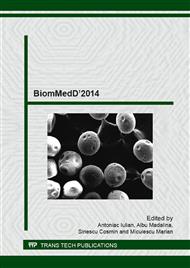p.274
p.280
p.286
p.296
p.303
p.310
p.316
p.322
p.327
Intelligent Collaborative Platform for Development of Personalized Surgical Orthopedic Guides
Abstract:
Currently, the processes of developing new medical devices (in particular, patient specific guides for orthopedic surgery being of interest in our research), is hampered by the difficulty of correctly and efficiently quantifying and translating the specific medical requirements in terms of technical specifications. This is caused by the intrinsic difficulty of the demarche, but also by a complicated communication between surgeon and engineer given the different practical and research perspectives, specific constraints, motivation, evaluation criteria and professional language barrier. The advent and development of new technologies with applications in the medical field, such as robotics, haptic-based virtual and augmented reality, additive manufacturing, collaborative modeling, knowledge-based support decision systems, etc., make now possible to bridge the gap between surgeons’ ideas and needs and their practical materialization into new customized medical devices. The paper enrolls in this research trend, presenting a general framework for the development of an intelligent e-health platform, which provides in a collaborative environment the necessary knowledge and computer-aided tools for translating surgeons’ needs into technical specifications for the design and manufacturing of patient-specific guides for orthopedic surgery. These guides can be used in the minimally invasive surgical procedures and for reducing the x-ray radiation exposure during surgery, and for increasing accuracy in performing different types of specific orthopedic surgical procedures such as cutting, drilling, tapping and aligning, by transferring the tools trajectories from computer-aided planning to surgery.
Info:
Periodical:
Pages:
303-309
Citation:
Online since:
March 2015
Authors:
Price:
Сopyright:
© 2015 Trans Tech Publications Ltd. All Rights Reserved
Share:
Citation:


